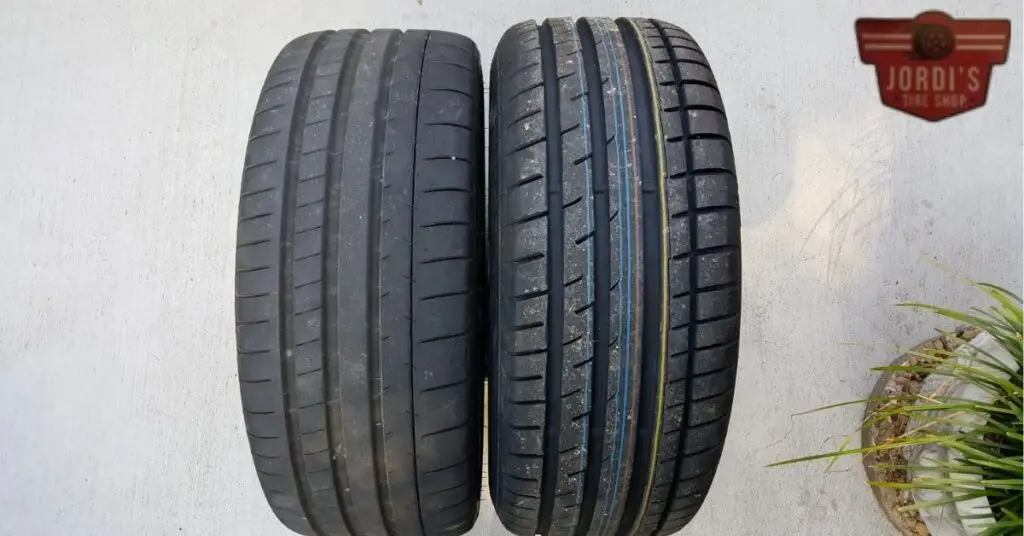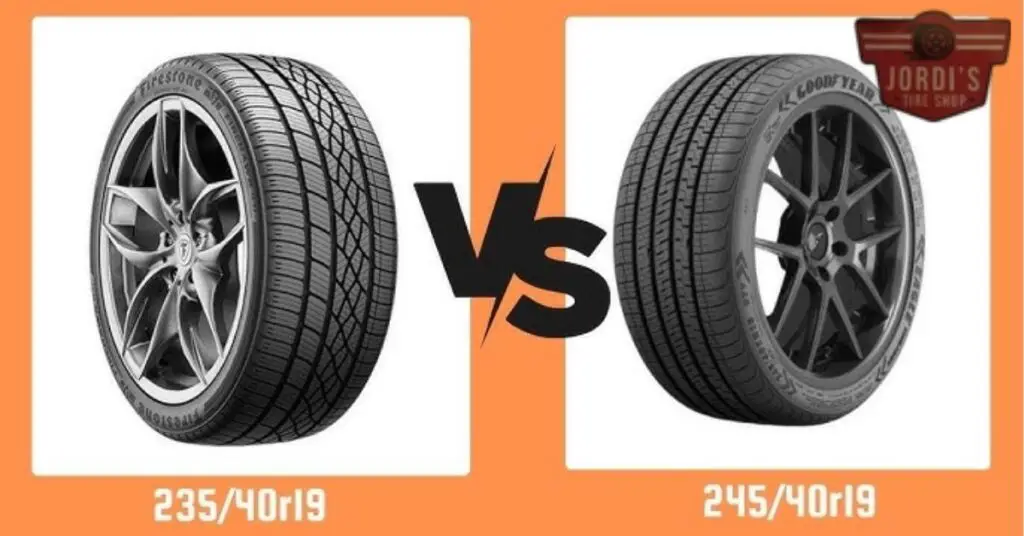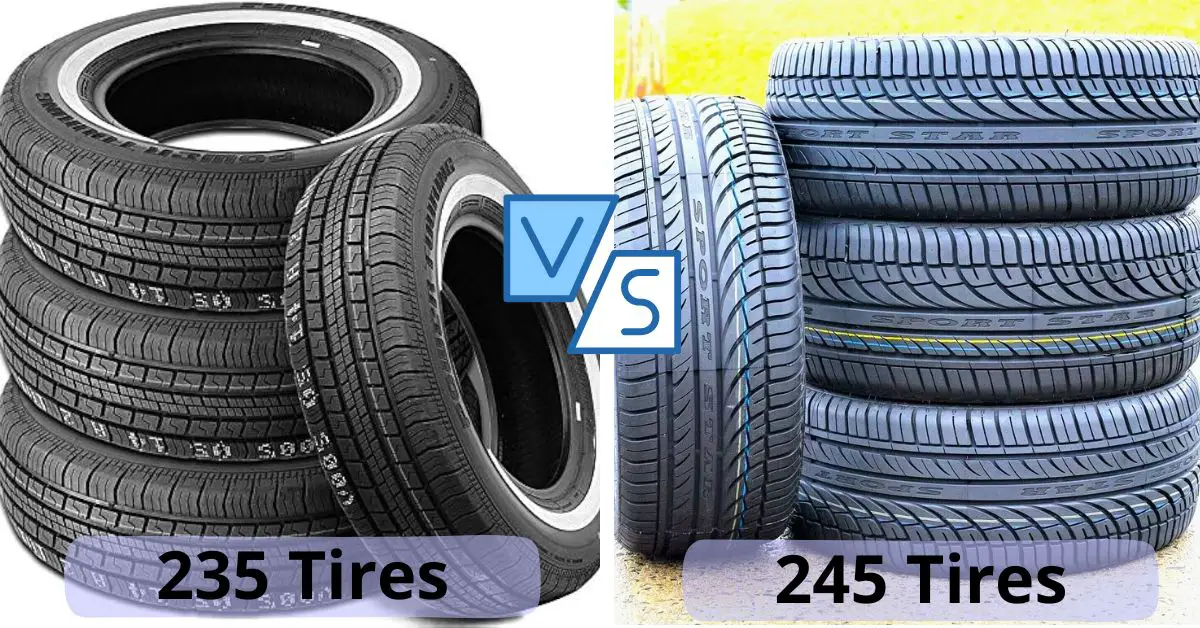Choosing the right tire size for your car can be a game-changer, and the debate between 235 and 245 tires is a hot topic among car enthusiasts. Both sizes have their unique advantages and potential drawbacks, making it essential to understand what each offers before making a decision.
A 245 tire, for instance, boasts a higher tire wall, which can enhance the vehicle’s aesthetic appeal and provide a more robust look. However, this increased size might lead to rubbing issues, especially on a 19-inch lowered setup. On the other hand, a 235 tire offers a more balanced fit that minimizes the risk of such problems. By understanding these differences, you can make a more informed choice that suits your driving needs and style preferences.
Overview of 235 and 245 Tires
Choosing between 235 and 245 tires depends on your vehicle type, driving style, and performance needs. Both sizes are common for SUVs, passenger vehicles, and light trucks.
Key Differences in Tire Sizes
Width:
235 tires measure 235 mm wide. In comparison, 245 tires are 245 mm wide, which is 10 mm wider. This extra width can enhance traction.
Diameter:
The diameter of 235 and 245 tires varies based on the aspect ratio and rim size. However, 245 tires generally have a slightly larger diameter.
Aspect Ratio:
245 tires often have a slightly lower aspect ratio compared to 235 tires, accommodating the increased width. This adjustment can slightly alter the tire’s profile and handling characteristics.
Applications and Vehicle Compatibility
Passenger Vehicles and SUVs:
235 tires are usually found on smaller cars, sedans, and compact SUVs. They offer a smoother ride and better fuel efficiency due to their smaller size. Examples include vehicles where a balanced performance without aggressive tread is desired.
Larger SUVs and Trucks:
245 tires are more common on mid-size SUVs and trucks. These tires provide improved stability and traction, beneficial for larger vehicles. Situations where enhanced grip and handling are required, such as off-road or heavy load conditions, are ideal for 245 tires.
Performance Comparisons

The difference between 235 and 245 tires significantly influences overall performance. These variations impact handling, speed, acceleration, and fuel efficiency.
Impact on Speed and Acceleration
Tire width affects a vehicle’s speed and acceleration. A 245 tire, being 10mm wider than a 235 tire, provides better grip. This increased traction improves acceleration, especially on dry roads, but might slow down top speed due to added rolling resistance. Speed ratings for each tire size, such as “H” or “V,” indicate maximum sustainable speed. For instance, “W” rated tires handle speeds up to 168 mph (270 kph).
Effects on Fuel Efficiency
Wider tires usually mean higher fuel consumption. A 245 tire has more surface contact with the road, increasing rolling resistance and reducing fuel efficiency compared to a 235 tire. Although the difference might seem minor, it becomes significant over time and distance. For fuel-conscious drivers, the 235 tire offers better fuel efficiency, making it a more cost-effective choice.
Handling and Stability
Tire width influences handling and stability. A 245 tire offers superior cornering due to its larger contact patch, enhancing stability at high speeds. However, the increased width may lead to issues like hydroplaning on wet surfaces. Conversely, a 235 tire provides adequate grip with less hydroplaning risk, making it suitable for varied driving conditions.
Handling and Comfort

Road Grip and Stability
Choosing between 235 and 245 tires impacts road grip and stability. 235 tires, with their narrower width, offer precise handling and better steering ideal for sports cars and high-performance vehicles. They excel in conditions requiring agility.
Conversely, 245 tires provide enhanced stability and grip. Their wider contact patch ensures elevated road traction, which is crucial for larger vehicles like SUVs and CUVs. This added grip improves cornering but increases the chance of hydroplaning on wet surfaces.
Comfort Level During Rides
Tire choice also affects ride comfort. 235 tires contribute to a firmer ride due to their smaller size, offering a connected feel to the road. This firmness can be beneficial in situations where precise control is necessary, such as in sportier driving scenarios.
On the other hand, 245 tires enhance ride comfort. Their larger diameter and width absorb road imperfections, promoting a smoother journey. This increased comfort and stability, especially at high speeds, makes them a favorite for long-distance travel and daily commutes on rougher roads.
Safety Implications

The choice between 235 and 245 tires influences vehicle safety significantly. Wider tires provide distinct advantages in traction and stability, affecting overall safety under various conditions.
Tire Size And Safety
Wider 245 tires offer 10mm more width than 235 tires. This increase enhances stability and grip, especially in wet conditions, reducing the risk of skidding or losing control. Wider tires generally improve traction, contributing to safer driving experiences. However, maintaining the correct tire pressure is crucial for both 235 and 245 tires to ensure optimal safety performance. Underinflated tires reduce traction, increase stopping distances, and risk tire failure.
Braking Distance Variations
Tire size affects braking distance. Wider 245 tires create a larger contact patch with the road, improving grip and potentially shortening braking distances. This feature becomes vital during emergency stops, particularly in wet or slippery conditions. Conversely, narrower 235 tires may not offer the same level of grip, possibly leading to longer stopping distances. The difference, though often small, can be critical in preventing accidents.
Handling In Various Weather Conditions
Handling varies with tire size in different weather conditions. In dry conditions, 245 tires provide better grip and improved cornering due to their wider contact patch. They also perform well in wet conditions, with better water dispersion reducing hydroplaning risks. Meanwhile, 235 tires offer adequate performance in dry conditions and can be satisfactory in wet conditions if paired with proper tread patterns and maintained pressure. However, in snowy or icy conditions, narrower 235 tires might perform better, slicing through the snow to reach the pavement, reducing slip risk.
Understanding these safety implications helps you choose the right tire size based on driving conditions and safety priorities.
Cost Implications

Understanding the cost implications of choosing between 235 and 245 tires can help you make an informed decision. The differences largely lie in initial purchase price, material costs, and labor costs.
Price Difference Analysis
Moderately priced 235 and 245 tires typically range from $100 to $300 each. High-end options, such as ultra-high-performance or specialty off-road tires, can cost between $300 and $500 each. Larger 245 tires often cost more than smaller 235 tires due to increased material usage, which can enhance performance.
Long-Term Cost Benefits
Evaluating long-term cost benefits is essential. Larger 245 tires may offer better stability and traction, potentially reducing wear and tear, though they come at a higher initial cost. Narrower 235 tires might provide better fuel efficiency due to lower rolling resistance, resulting in cost savings over time. Balancing performance needs with budget constraints can guide you in selecting the optimal tire size for your vehicle.
Conclusion
Choosing between 235 and 245 tires depends on your vehicle type, driving conditions, and budget. If you drive a sports car and prioritize precise handling, 235 tires might be your best bet. For SUV owners seeking enhanced stability and grip, 245 tires offer significant advantages, particularly in wet conditions.
Safety is a crucial factor to consider. Wider 245 tires generally provide better traction and shorter braking distances, while narrower 235 tires can perform better in snowy or icy conditions. Additionally, maintaining proper tire pressure is essential for optimal performance and safety.
Cost considerations also play a role. While 245 tires may have a higher initial cost, they could offer long-term benefits like reduced wear and tear. On the other hand, 235 tires might be more fuel-efficient, potentially saving you money in the long run.
Ultimately, balance your performance needs with your budget to make the best decision for your vehicle.
Related Posts:
- 225 vs 245 Tires: Which Size is Best for Your Vehicle’s Performance and Comfort?
- 235 vs 245 Tires: A Comprehensive Guide to Choosing the Right Size for Your Vehicle
- 275 vs 285 Tires: Performance, Fuel Efficiency, and Cost Comparison Explained
- 225 vs 235 Tires: Which Offers Better Performance and Fuel Efficiency?










